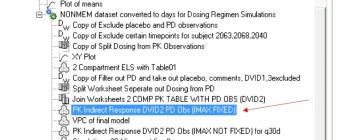Hello,
I wanted to ask some input and advice from the community regarding a population PK/PD model I have been working on.
Our final model is a 2-compartment extravascular with an indirect response. More recently I have also added in an effect compartment to the indirect model which improved the log likelihood, so I plan to keep it in. The indirect model is an inhibitory response, inhibition limited of buildup. Do any of you also have experience adding an effect compartment into an indirect response model, does this logic make sense to basically add an additional delay in observed effect?
My general workflow has been to do the population PK first, obtain both the theta estimates by individual and generate a table with the parameters for each subject (Table 01 in the final PK model) Ka, V, V2, Cl, Cl2.
I then merge the PK parameters (Table 01 output) with the observed PD and fix the PK parameters to 1 but map the individual PK parameters as “covariates” that drive the PD.
The model runs fine, all diagnostics seem acceptable, the only parameter that we fixed is really the Imax set to 1 (this is necessary for our model). However, I have noticed that the Pop DV vs IPRED Log for Effect has improved substantially when we have IMAX unfixed ( usually estimates to 1.14). When we have Imax fixed to 1 the diagnostics seem to over predict at the lower end. That is my first question if there is anything to do about that, basically improving the model diagnostic while still keeping Imax fixed to 1 (not my major concern).
After I have the final model I then do some dosing regimen simulations for the population (weekly, monthly, and quarterly) for 10,20,30,40, 60,80, and 100mg doses.. This is where my real question is. I am asking how to fix the baseline value in my model. For example, we are inhibiting the production of a protein in plasma, and each of the individuals in the population will have different baseline levels of this protein. For my simulations I am getting a random baseline value for each of my dose cohorts, with such high variability.
Ideally I would like to fix this value, for example 3 separate simulations for 3 different fixed baselines (i.e. 300nM, 140nM, and 60nM) where all dose cohorts start at the same baseline, and looking at the inhibitory effect.
It seems I am currently running into a problem for example where the 60mg cohort looks more potent then the 80mg cohort because the simulated baseline for the 60mg is lower then the 80mg (and each time I run the model this is random). I end up having to import so many simulation tables until I get one that looks decent. Each of the dose groups are randomly simulating to different baselines, sometimes the 100mg cohort is the highest baseline , whereby the 80mg cohort has a much lower baseline, so the raw values look different. Ideally it would be good to simulate each of these cohorts with the same “fixed” baseline.
I also have attached a photo.
Thank you for your great help and wish you all the very best!

Edited by csheme, 16 April 2016 - 02:14 PM.















